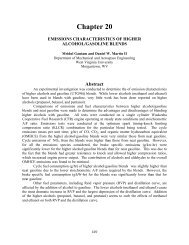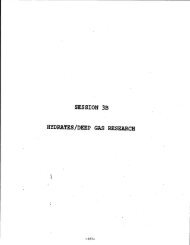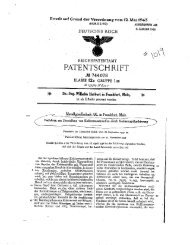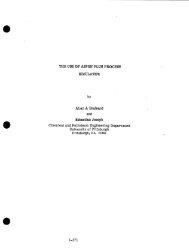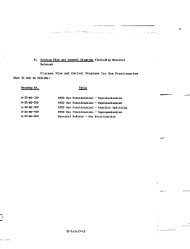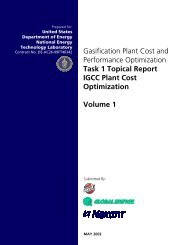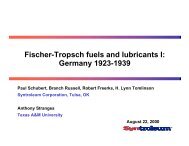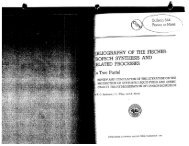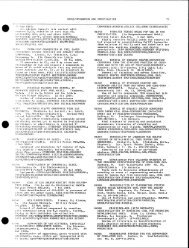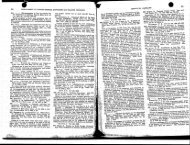alternative fuels for medium-speed diesel engines (affmsde) project
alternative fuels for medium-speed diesel engines (affmsde) project
alternative fuels for medium-speed diesel engines (affmsde) project
Create successful ePaper yourself
Turn your PDF publications into a flip-book with our unique Google optimized e-Paper software.
I IIMIMIIIIIIIIIIIIIIIIIIIIIIIIIIIIIIIIIIIIIIIIIIIIIII<br />
DE83002565<br />
One Source. One Search. One Solution.<br />
ALTERNATIVE FUELS FOR MEDIUM-SPEED DIESEL<br />
ENGINES (AFFMSDE) PROJECT: A BASELINE<br />
PROGRAM PLANNING CONCEPT FOR REVIEW AND<br />
REVISION. FINAL REPORT<br />
E:F TECHNOLOGY, INC.<br />
ST. JOHNS, MI<br />
JUN 1982<br />
U.S. Department of Commerce<br />
National Technical In<strong>for</strong>mation Service
One Source. One Search. One Solution.<br />
Providing Permanent, Easy Access<br />
to U.S. Government In<strong>for</strong>mation<br />
National Technical In<strong>for</strong>mation Service is the nation's<br />
largest repository and disseminator of government-<br />
initiated scientific, technical, engineering, and related<br />
business in<strong>for</strong>mation. The NTIS collection includes<br />
almost 3,000,000 in<strong>for</strong>mation products in a variety of<br />
<strong>for</strong>mats: electronic download, online access, CD-<br />
ROM, magnetic tape, diskette, multimedia, microfiche<br />
and paper.<br />
Search the NTIS Database from 1990 <strong>for</strong>ward<br />
NTIS has upgraded its bibliographic database system and has made all entries since<br />
1990 searchable on www.ntis.gov. You now have access to in<strong>for</strong>mation on more than<br />
600,000 government research in<strong>for</strong>mation products from this web site.<br />
Link to Full Text Documents at Government Web Sites<br />
Because many Government agencies have their most recent reports available on their<br />
own web site, we have added links directly to these reports. When available, you will<br />
see a link on the right side of the bibliographic screen.<br />
Download Publications (1997 - Present)<br />
NTIS can now provides the full text of reports as downloadable PDF files. This means<br />
that when an agency stops maintaining a report on the web, NTIS will offer a<br />
downloadable version. There is a nominal fee <strong>for</strong> each download <strong>for</strong> most publications.<br />
For more in<strong>for</strong>mation visit our website:<br />
www.ntis.gov<br />
. ,~-~,~<br />
U.S. DEPARTMENT OF COMMERCE<br />
Technology Administration<br />
National Technical In<strong>for</strong>mation Service<br />
Springfield, VA 22161
DE83002565<br />
I IIllllltlllllllllllllllillllllllllllllllllllllll[lllllIIIIl
DE83002565<br />
I IIMIIIIIIIIIIIIIIltlIIIlflIIIIIIIIIIIIIIII<br />
DOE/CS/50048-'I" I<br />
The Alternative Fuels <strong>for</strong><br />
Medium-Speed Diesel Engines {AFFMSDE) Project:<br />
E:F TECHNOLOGY INC.<br />
Teleplnone (517) 224-3268<br />
A Baseline Program Planning Concept<br />
<strong>for</strong> Review and Revision<br />
Prepared by:<br />
E:F Technology, Inc.<br />
St. Johns, Michigan<br />
FINAL REPORT<br />
under<br />
N~TICE<br />
U.S Department of Energy<br />
Contract No. DE-ACO2-81C$50048.MO02<br />
June 1982<br />
PORT!gR£ ~---' :~ ~E?9~T .~RE !LLEG|~3LE. It<br />
:;~y to p;;;;!2;'.:~ '2 - 2: .,:css;b;e ava:,l-<br />
"!'iHt'i.<br />
~ISTR!gUT:?': "-': !~:2- i<br />
P.O. Box 189<br />
St. Johns. MI 48879-0189<br />
..... 1 ", " ~'-" ,"~-<br />
', "-" IT .'3 ~' ..........
Medium<br />
DOZ/CS/500 z ~;~ ~ -~ _.%<br />
DZ83 002555<br />
___________~E/CS150048-1"~'~<br />
The Alternative Fuels <strong>for</strong><br />
Speed Diesel Engines (AFFMSDE) Project:<br />
A Baseline Program Planning Concept<br />
<strong>for</strong> Review and Revision<br />
NOT',CE<br />
PORTIONS OF 7F'.~ .~ =~9.~ ~ ~,P, ...........<br />
~'it'/,<br />
Prepared by:<br />
E:F Technology, Inc.<br />
St. Johns, Michigan<br />
FINAL REPC)RT<br />
under<br />
U.S Department of Energy<br />
Contract No. DE-AC02-81CSSOO48.MO02<br />
June 1982<br />
DIST~IBUTIO~'~ OF TH!S .... ,-,--.,T t~ tJ~'~LIMiTED
Suction i - 5U~.t~t%RY<br />
Section 2 - INTRODUCTION<br />
2. ! Program Background<br />
2.2 Accomplishments<br />
2.3 Purlxose of Thls Document<br />
2.4 Contents<br />
TABLE OF CONTENTS<br />
SectioD 3- SUGGESTED PROGR~M O~ECTIVES, REQUIREMENTS, AND<br />
PRIORITIES DISCUSSION<br />
3. ! Objectives<br />
3. 2 Re,i~iremen ts<br />
3. ? Priority Considerations<br />
Section 4 - A SUGGESTED MULTI-Y~A_R RESEARCH, DEVELOPMENT, AND<br />
OPERATIONAL DE~IONSTP~TION PROG.R~%51 PLAN<br />
a. 1 Ce~eral comments and Obsez-vations<br />
4.1.1 Scope of Objectives Suggested<br />
4.1.2 AntLcipated Management Problems<br />
4.1.3 Planned In<strong>for</strong>mation Disseminat=c.q<br />
4.1.4 Addltiona! Program Components Suggested<br />
~.2 Supporting Tasks Component<br />
~.3 Planned In<strong>for</strong>~ation Dissemination Components<br />
4.4 The Multi-Year Research, D~velol~en~., and Operat~onai<br />
De_monsr_ration Progr~m Project<br />
4.4.1 Basic Logic of Activity Areas<br />
4.4.2 Basic Logic or RiD zn Stationary Enqines<br />
4.4.3 B~sic Loqic of O}~erational Demonstrdt~o~,<br />
4.4.4 Work Areas<br />
• -. 5 The_ Program P!~n Proposed<br />
-~.5.1<br />
4.5.2<br />
5.3<br />
4.5.4<br />
A Concept <strong>for</strong> :
Section 6 - MANAG~.~NT APPROACH<br />
Section 7 - BUDGETARY ESTi~.~TES<br />
7.1 Basic Project Budget<br />
7.2 Cash Flow Requirements<br />
Section 8 - ~ECO~.~T/~DATXONS<br />
Figure 1<br />
Figure 2<br />
Figure 3<br />
Ficure 4<br />
Pl~urc 5<br />
Figure 6<br />
Ficure 7<br />
Figure 8<br />
Figure 9<br />
Figure !0<br />
TABLE OF CONTENTS, Continued<br />
LIST OF FIGURES<br />
Electro-Motive Division 2-Cylinder, 567 Cubic Inches/<br />
Cylinder, Normally Aspirated Research Test Engine at<br />
Southwest Research Institute in San Antonio, Texas<br />
The Rail Motive Power Laboratory at Sou~'_hwest Research<br />
Imstztute Consisting of a 12-Cy!inder Turbocharged General<br />
Electric 7FDL Medium-Speed Diesel Engine and an Electro-<br />
Motive Division of General Motors 12-Cylinder Turbocharged<br />
645 E3B Medium-Speed Diesel Engine<br />
Control Room of the AAR/Southwest Research Institute<br />
Rail Motive Power Laboratory<br />
Examples of Classes of Alternative Fuels and Some<br />
Examples of Such Fuels<br />
Presently Prol~sed Areas of Investigation Comprising the<br />
Al~ernative Fuels <strong>for</strong> Medium-Speed Diesel Engines (AFF~DE)<br />
Pro3ect Ac~ivities<br />
Progressive Levels of Testing cf Alternative Fuel Systems<br />
in 2-Cylinder Stationary, Multi-Cylinder Stationary and<br />
Rail Operating Environments<br />
Proposed Multi-Year Program Planning Concept <strong>for</strong> the<br />
AFF~DE Program<br />
Xodified SD45-2 Alternative Fuels Research Motive Power Unit<br />
PERT/CPM Chart<br />
AFFMSDE Management Structure Suggested by Recent and<br />
Pro!~osed SwF_I end ,~-%R Initiatives<br />
ii<br />
C~<br />
Page<br />
27<br />
29<br />
29<br />
29<br />
32<br />
15<br />
16<br />
18<br />
20<br />
24<br />
25<br />
28
LIST OF FIGURES, Continued<br />
Figure ll Basic Budgetary Estimates t,f the Multi-Year AFF~L~DE<br />
Program<br />
Figure 12 Cash Flow Requirements Es~ima=es ~f the Multi-Year<br />
AFFMSDE Program<br />
iia<br />
Page<br />
30<br />
31
Section l<br />
SUMMARY<br />
The major problem that is implicit in this multi-year, essentially<br />
vol~tarily supported program is t/%e maintenance of voluntary support <strong>for</strong><br />
what is an ambitious, technically difficult and large-scale program.<br />
It as st/~ngly suggested that the development and <strong>for</strong>mal adoption, by<br />
all ~-~rticipants, of a multi-year Program Management Plan might provide a<br />
means of focusing attention on r_his difficult management aspect and thus a<br />
means of contributing to developing a commitment to support of the program<br />
<strong>for</strong> its fL~ll duration and to achieving the final objectives sought.<br />
Whatever the results of the program activities, they must be accompanied<br />
by tne effective dissemination of in<strong>for</strong>mation regarding all program findings.<br />
It is recommended that this problem receive specific attention and that a<br />
planned approach zo in<strong>for</strong>mation dissemination be developed and maintained.<br />
The reader should remember that during the past four years of the AFFMSDE<br />
program, theze have been a number of "gluts" in petroleum supply. At this<br />
time, another such "glut" is coming to an end. However, in the present<br />
circumstances, there are indications that the price of petroleum <strong>fuels</strong> may<br />
not rise significantly <strong>for</strong> some time in the fu~:ure because of inter-hal<br />
discord in the OPEC producing nations. On the other hand, the inherent<br />
instability of the Middle East has never been more apparent than it is<br />
today. The potential signiflcance of the proposed program to the U.S.<br />
rail indusUy in this period of uncertainty of continued supply of crude<br />
oil from <strong>for</strong>eign producers is obvious.<br />
The purpose of this document is to provide some suggestions and recommend-<br />
ations <strong>for</strong> thu long-term continuation of the Alternative Fuels <strong>for</strong> Medium<br />
Speed Diesel Engines (AFFMSDE) Program as program supi~rt transitions from<br />
government to industry.<br />
The ~.:Jlti-Year Program Manag~nent Plan presented here is a suggested<br />
baseline concept. If it is subject to review, revision, and expansion in<br />
detail by contribution of all program participants, it might provide assistance<br />
in developing long-term, planned, commitment to supporting and maintai:~ing<br />
continuity of management that these types of program require.
J ,<br />
f<br />
I<br />
l<br />
d<br />
J<br />
;L~ "<br />
• ' "'~L<br />
Fig. Electro-Motive Divisien 2 Cylinder, 567 Cubic Inches/Cylinder,<br />
Normally Aspirated Research Test Engine at Southwest Research<br />
~ns,ltute in San Antonio, Texaa.
6~<br />
lllitl<br />
/<br />
Fig. 2<br />
£-,~.<br />
,r,<br />
iFi.,o~ '.~i " I<br />
i;:ii, !,'J<br />
• r<br />
~,4 .'~-<br />
'*'i I , • :.<br />
The Rail Hotive Power Laboratory at SouLhwest Research InstJLuLe consisting of<br />
a 12 Cylinder Turbocharged General Electric 7FDL <strong>medium</strong> <strong>speed</strong> <strong>diesel</strong> engine and<br />
an ElecLro-HoLive Divison of General Motors 12 Cylinder, Turbocharged 645 E3B<br />
<strong>medium</strong> <strong>speed</strong> <strong>diesel</strong> engine.<br />
#<br />
IV*~ i , .~......,',w<br />
"~',.~,.C;~ i:. '<br />
i
Fig. 3<br />
Control Room of the AAR/Southwest Research Institute Ra|l Motive<br />
Power Laboratory.
2.1 Program Background<br />
Section 2<br />
INTRODUCTION<br />
The Alternative Fuels <strong>for</strong> Medium-Spee~ Diesel Engines (AFF~DE) Program<br />
was initially funded by the Non-Highway Transportation Systems Branch of the<br />
U.S. Department of Energy in August 1978. The general objective of the pro-<br />
gram was to iaentify means of conserving petroleum resources through two<br />
strategies. First, t~,rough the use of petroleum-based <strong>fuels</strong> with properties<br />
deviating significantly from conventional specification <strong>diesel</strong> <strong>fuels</strong>. Secondly,<br />
through the use of fossil <strong>fuels</strong> not derived from petroleum.<br />
!~: "??9, the: !.'ederal Railroad Administration of the U.S. Departmen~ of<br />
Trans!~ort~tion (DOT/FRA) and the Association of American Railroads (AAR)<br />
joined the 2rogrmm ef<strong>for</strong>t providing additional financial support.<br />
Member railroads of the AAR contributed two rail <strong>diesel</strong> <strong>engines</strong>--a 12-<br />
cylinder General Electric (GE) 7FDL turbosupercharged <strong>medium</strong>-<strong>speed</strong> engine and<br />
a General Motors (GM) Electro-Motive Division 12-cylinder turbosupercharged<br />
645 E3B <strong>medium</strong>-<strong>speed</strong> <strong>diesel</strong> engine--to the <strong>project</strong>. These <strong>engines</strong> were deliv-<br />
ered to Southwest Research Institute (SwR!) in 1980.<br />
SwRI contributed all facilities, operational support and instrumentation<br />
systems equipment needed to complete the installation of these two <strong>engines</strong> in<br />
SwRi's facilities at San Antonio, Texas. This multi-cylinder Rail Motive<br />
£;ower iaboratory is supported by an already existing 2-cylinder GM/F/4D Model<br />
567 research engine installation.<br />
2 - 2 Accomplishments<br />
The characteristics of operation of <strong>medium</strong>-<strong>speed</strong> <strong>diesel</strong> <strong>engines</strong> on petro-<br />
leum-based <strong>fuels</strong> with significant deviation from ~he Diesel No- 2 specifica-<br />
uion property limit have been investigated and the findings documented.<br />
The characteristics of operating <strong>medium</strong>-<strong>speed</strong> <strong>diesel</strong> <strong>engines</strong> on fuel<br />
<strong>for</strong>ms representative of syn<strong>fuels</strong> or <strong>alternative</strong> <strong>fuels</strong> derived from non-petroleum<br />
foss~l resources have been studied and the findings have been reported.<br />
A full-scale rail engine research facility has been created. This facil-<br />
ity is capable of running 2-cylinder and multi-cylinder <strong>engines</strong>, <strong>fuels</strong>, lubri-<br />
5
cants, additlves, and equipment research and development programs using repre-<br />
aentative <strong>medium</strong>-<strong>speed</strong> <strong>diesel</strong> equipment of contempordry design. This facility<br />
is su}~l~rted by [Jersonnel exl~erienced in <strong>fuels</strong> research and technology, lubri-<br />
cants research and technology, combustion and emissions research, and the<br />
design development, and evaluation of <strong>medium</strong>-<strong>speed</strong> <strong>diesel</strong> engine equipment<br />
s~,stems and subsystems.<br />
2.3 Purpose of This Document<br />
Continuing funding support of the AFFMSDE Program by DOE and DOT/FRA is<br />
being curtailed. The program wil! be continued by the Association of ~meri-<br />
can Railroads and its member lines.<br />
The purpose of this document is to provide some suggestions and recommen-<br />
dations <strong>for</strong> the long-term continuation of this program as this support transi-<br />
tion is made from government to industry.<br />
Th~ Multi-Year approach to Program Management Planning presented here is<br />
a suggested baseline concept. If it is subjected to review, revision, and<br />
expansion in detail by all program participants, it migl~t provide some assis-<br />
tance in developing long-te~m, planned, support and continuity of management<br />
that progra/ns of this type require.<br />
2.4 Contents<br />
This document is a major revision of the "Alternative Fuels foL ~;edium-<br />
Speed Diesel Engines: Project Management Master Plan" of AEril 1979, as pre-<br />
i~red by Escher Technology Associates, Inc., in accord with the <strong>for</strong>mat recom-<br />
mendations of DOT/FRA. The immediately following section, Section 3, presents<br />
suggested program ob3ectives , requirements zesultlng from these objectives,<br />
and a discuss&cn of prioritization of program objectives and requirements.<br />
A Program Plan Proposal is presented in Section 4_ The proposed program plan<br />
embraces three major areas of activities:<br />
• Supporting Tasks<br />
• Planned In<strong>for</strong>mation Dissemination<br />
Research, Development and Operational Demonstration<br />
Activities.<br />
6
The remaining sections are comprised of brief discussions of program<br />
products and/or deliverables <strong>project</strong>ed, a suggested basic management approach,<br />
generalized budgetary estima%es, and principal recommendations from all of the<br />
above.<br />
7
Section 3<br />
SUGGESTED PROGRAM OBJECTIVES, REQUIREMENTS, AND PRIGRITIES DISCUSSION<br />
3.1 Ob3ec~ives<br />
The basic scope of the AFFMSDE Program is concerned exclusively with<br />
energy-related aspects of operation of the <strong>medium</strong>-<strong>speed</strong> <strong>diesel</strong> <strong>engines</strong> in<br />
rail motive power units. The program has not been concerned, and it is recom-<br />
mended that it should not be concerned, with improvements related to opera-<br />
tzonal a:tivities in rail motive power unit use. There is an exception to<br />
~his consideration. This exception is in consideration of the problems of<br />
operation using <strong>alternative</strong> fuel systems as they affect the original equipment<br />
manufacturers, operating companies utilizing such systems, and the production,<br />
distribution, storage, and delivery of non-petroleum based <strong>alternative</strong> <strong>fuels</strong><br />
by manufacturers of such <strong>fuels</strong>.<br />
The overall objectives of the AFFMSDE Program are:<br />
I. To zdentify problems, and to develop technical approaches in solution<br />
of those problems, associated with rail line operation of <strong>medium</strong>-<strong>speed</strong><br />
<strong>diesel</strong> <strong>engines</strong> on:<br />
• <strong>diesel</strong> <strong>fuels</strong> derived from petroieum with properties significantly<br />
deviating from conventional specification <strong>diesel</strong> <strong>fuels</strong><br />
• <strong>fuels</strong> derived from "syncrudes" from coal, oil shale, and tar sands<br />
• <strong>alternative</strong> <strong>fuels</strong>, the use of which may be required because of a<br />
lack of adequate supplies of <strong>fuels</strong>, petroleum, coal, oil shale, and<br />
tar sands resources.<br />
2. To identify the nature of, and quantify to the extent appropriate and<br />
~ractical, the problems of operation on <strong>alternative</strong> fuel systems that<br />
will be encountered by original equipment manufacturers and rail line<br />
operating companies utilizing such fuel systems<br />
3. To effectively disseminate in<strong>for</strong>mation resulting from r_he activities of<br />
the AFFMSDE Project.<br />
3.2 Requirements<br />
In order to achieve the overall <strong>project</strong> objectives, the program of work<br />
comprising t_he AFF~-SDE Program Planning Concept pzesented herein provides<br />
an arrangement of activities which meet or fulfill the following requirements:
i.<br />
2.<br />
3.<br />
4.<br />
5.<br />
6.<br />
To provide an orderly identification of the problems associated with<br />
the operation of <strong>medium</strong>-<strong>speed</strong> <strong>diesel</strong> <strong>engines</strong> on <strong>alternative</strong> fuel <strong>for</strong>ms<br />
To identify technological approaches to the solution of these problems<br />
To evaluate the adequacy of these approaches by operation of two-cylinder<br />
stationary, multi-cylinder stationary, and rail motive power equipment<br />
systems on such alnernative fuel <strong>for</strong>ms<br />
To provide an orderly identification of the problems associated with the<br />
conversion of <strong>medium</strong>-<strong>speed</strong> <strong>diesel</strong> <strong>engines</strong> to <strong>alternative</strong> fuel <strong>for</strong>ms that<br />
will be encountered by original equipment manufacturers<br />
To provide a similar identification of such problems as they would be<br />
encountered by rail line operating companies using such <strong>engines</strong> converted<br />
uo operauion on such fuel <strong>for</strong>ms<br />
To provide an orderly program of planned in<strong>for</strong>mation dissemination to be<br />
executed that will assure the in<strong>for</strong>mation resulting from the AFFMSDE<br />
<strong>project</strong> will be available to appropriate individuals in those industries<br />
that may make use of the investigated fuel <strong>for</strong>ms in <strong>medium</strong>-<strong>speed</strong> <strong>diesel</strong><br />
~ngines.<br />
3.3 Priority Considerations<br />
It is suggested that all program activities proposed should be evaluated<br />
in terms of the following priority considerations :<br />
i. To reduce direct costs of rail operating companies<br />
2. To assure the maximum probability of the ability to continue to operate<br />
under the broadest range of fuel availability scenarios possible<br />
3. To conserve petroleum fuel resources<br />
4. To conserve fossil fuel resources.<br />
It must be noted that if priority No. 1 is the only consideration, the<br />
resultimg program of activities will be of narrow scope and will be concerned<br />
only with the near-term. It is suggested that ,~ii priorities must be consid-<br />
ered and that available resources should be reasonably apportioned between<br />
activities that fall in all four priority categories.
Section 4<br />
A,SUGGESTED MULTI-YEAR RESEARCH, DEVELOPMENT, AND OPERATIONAL<br />
DEMONSTRATION'"'PROGRAM PLAN<br />
q.l General Comments and Observations<br />
4.1.1 Scope of Ob3ectives suggested<br />
To date, t-he scope of work on the AFFMSDE Program has been concerned with<br />
types of operations that can generally be classified as being "research"<br />
oriented. Tasks accomplished to date have been concerned with identifying<br />
the combustion characteristics and the per<strong>for</strong>mance of various <strong>alternative</strong> <strong>fuels</strong><br />
introduced into <strong>medium</strong>-<strong>speed</strong> <strong>diesel</strong> engine combustion systems using a variety<br />
of approaches. Injector systems, emulsifiers, etc., have been constructed to<br />
satisfy experimental ob]ectiveso This hardware and equipment has not been<br />
designed to meet the requirements of operating rail equipment systems.<br />
If the program is to evolve out of research-oriented activities in the<br />
fields of combustion and engine per<strong>for</strong>mance, the next logical step is the<br />
development of selected <strong>alternative</strong> <strong>fuels</strong>/engine equipment systems capable of<br />
sustained operation with per<strong>for</strong>mance, reliability, and maintainability charac-<br />
teristics appropriate to rail operational use.<br />
If the AFFMSDE Program is to continue beyond the developmental phase, the<br />
program objective would logically expand to include demonstration of the use<br />
of these selected <strong>alternative</strong> fuel systems in representative rail operating<br />
environments.<br />
4.1.2 Anticipated Management Problems<br />
Even if the AFFMSDE Program were to begin to be managed as a pre-planned,<br />
adequately funded, and vigorously pursued program, at least five to seven<br />
>'ears would be required to accomplish the major objectives briefly discussed<br />
above.<br />
The reader should remember --hat during the past four years of the AFFMSDE<br />
Program, there have been a ncber of "gluts" in petroleum supply. At this<br />
tlme, another such "glut" is coming to an end. However, in the present cir-<br />
cumstances, there are indications that the price of petroleum <strong>fuels</strong> may not<br />
rise significantly <strong>for</strong> some ~ime in ~-he future because of internal discord<br />
10
wit/nan the OPEC producing nations. On the other hand, the inherent instabil-<br />
ity of the ~ddle East has never been more apparent than it is today.<br />
Past support of the AFFMSDE Program has been maintained by a cooperative<br />
funding approach involving DOE, DOT/FRA, and the AAR. Support of the program<br />
is now being assumed by the AAR. It is obvious that future support will de-<br />
pend heavily on the endorsement and participation of the operating rail com-<br />
panies comprising the AAR. It is suggested that success of the overall pro-<br />
~ect depends and requires continuous participation and support by the rail<br />
operating companies regardless of the vagaries and vacillating happenings of<br />
the World energy market.<br />
The major management problem that is implicit in this multi-year, essen-<br />
tially vo!u;~tarily supported program is the maintenance of this voluntary sup-<br />
port <strong>for</strong> what is an ambitious, technically difficult, and a large-scale pro-<br />
gram. It is sarongly suggested that the development and <strong>for</strong>mal adoption, by<br />
all participants, of a multi-year Program Management Plan might provide a<br />
means of fozusing attention to this difficult management aspect and thus a<br />
means of contributing to developing a con~nitment to support of the program<br />
<strong>for</strong> its full duration by the AAR's member lines.<br />
4.!.3 Planned In<strong>for</strong>mation Dissemination<br />
To date, the overal) objective of the activities per<strong>for</strong>med under the<br />
AFFMSDE Program have been concel'ned with reduction of the levels of uncertainty<br />
associated with the use of <strong>alternative</strong> <strong>fuels</strong> in rail motive power systems.<br />
I~ is suggested that these objectives should be expanded to include additional<br />
technological aspects of energy use in motive power units generally. It is<br />
suggested ~hat there are five categories or dimensions of uncertainty:<br />
1. Technological uncertainty<br />
2. Cost uncertainty<br />
3. Demand uncertainty<br />
4. Institutional uncertainty comprised of internal and external institutional<br />
uncertainty<br />
5. Uncertainty about externalities outside the institutional system.<br />
ll
To date, the AFFMSDE Progr~T, has been concerned almost exclusively with<br />
the single consideration of eliminating technological uncertainty associated<br />
with the use of <strong>alternative</strong> <strong>fuels</strong>. Even in this area of program concentra-<br />
5ion, the program has progressed only in ",he "research" phase. Identifying<br />
the problems and the solutions to the problems of operating with these fuel<br />
systems requlres the development of reliable, 1ong-!ived and maintainable<br />
engine systems operating on selected <strong>alternative</strong> <strong>fuels</strong> and the demonstration<br />
cf the use of these <strong>alternative</strong> <strong>fuels</strong> in operating rail environments.<br />
Whatever the results of r_he program activities, they must be accompanied<br />
by nhe effective dissemination of in<strong>for</strong>mation regarding all program findings<br />
in these areas of uncertainty and the extent to which this uncertainty has<br />
been reduced.<br />
It is recommended that in<strong>for</strong>mation dissemination be identified as a spe-<br />
cific task or activity area. An effective in<strong>for</strong>mation dissemination program<br />
should be designed and specific responsibility <strong>for</strong> its continuous execution<br />
provided <strong>for</strong> in all program-related activities.<br />
4. i. 4 Additional Program. Component5 Suggested<br />
At the present time, there is no <strong>for</strong>mally documented, multi-year program<br />
plan developed by, and agreeable to, the participants in the AFFMSDE Program.<br />
Present activities are almost exclusively research oriented. These activiti~-s<br />
<strong>for</strong>m the basis from which any multi-year program plan must evolve.<br />
These research activities should evolve through development to opera-<br />
tional demonstration if a multi-year program management approach is to be<br />
used in the AFFMSDE Program. These activities--research, development, and<br />
operational demonstration of <strong>alternative</strong> fuel systems--<strong>for</strong>m the "core" of a<br />
logical program plan.<br />
However, ~wo additional program components are suggested. First, the<br />
addition of a "Supporting Tasks" component addressing the many peripheral as-<br />
[,ec~s of the use of <strong>alternative</strong> <strong>fuels</strong>, fuel conserving technology, energy<br />
recovery technology, system~ analysis, and systems economics studies, etc.<br />
The second new prognam component suggested is a planned in<strong>for</strong>mation dissemin-<br />
ation activity as has been discussed.<br />
12
These three major program components should be restricted to consideration<br />
of powerplan~s in rail motive power units and the servicing and s~ppor~ equip-<br />
men~ and persor.nel systems directly related to motive power unit operation.<br />
Problems related to the operational -use of these equipment systems in<br />
rail operating environment, and the general problem of energy use and energy<br />
conservation in rail operations, should not be within the purview of this pro-<br />
gram but should fall within the purview of the Energy Steering Committee of<br />
the AAR.<br />
4.2 Supporting Tasks Component<br />
It is suggested that some means be developed to carry out individual<br />
supporting tasks, on a scheduled and direct basis, into such subject areas as:<br />
• Alternative <strong>fuels</strong> availability<br />
• Safety in fuel handling, storaqe, and distribution in rail operations<br />
• Alternative <strong>engines</strong> and combinations of <strong>alternative</strong> <strong>engines</strong> and<br />
<strong>alternative</strong> fuel systems<br />
• Energy ~onservation opportunities in motive power unit powerplants<br />
• Energy recovery technology in motive power unit powerplants<br />
• Systems economics considerations including the impact of the use of<br />
aulernative <strong>fuels</strong> and other technological developments on fuel pro-<br />
ducers, rail equipment manufacturers, ~--.~ operating companies.<br />
Factors considered should include, among or_her considerations, the<br />
• mpac~ on present equity values, the total real costs of conversion,<br />
the impact on costs of operetion, and rail customer rate impacts.<br />
4.3 Planned ~n<strong>for</strong>mation Dissemination Components<br />
. , , , ,<br />
A planned ef<strong>for</strong>t should be undertaken to identify the specific in<strong>for</strong>mation<br />
needs of rail operating companies <strong>for</strong> the in<strong>for</strong>mation products, in whatever<br />
<strong>for</strong>m, tc be produced by ~he AFFMSDE Program. A system <strong>for</strong> presenting this<br />
in<strong>for</strong>mation in the most effective manner, i.e., written documentation, work-<br />
shops, seminars, extensive reports, physical demonstrations, etc., should be<br />
developed i~eratively with the identification of the specific recipients iden-<br />
tified within the AAR organizational structure &nd operating companies. This<br />
in<strong>for</strong>mation should be brought together into a documented in<strong>for</strong>mation dissemin-<br />
ation program compatible with the research, development, and operational dem-<br />
13
onstration program plan. Responsibility <strong>for</strong> its execution should be assigned<br />
to 3pccific individuals with the appropriate skills and adequate funding s~p-<br />
[mrt, within the overall program budget, provided.<br />
4.4 The Multi-Year Reseaxch, Development, ~nd Operational Demonstration Pro-<br />
gram Project<br />
4.4.1 Basic Logic of Activity Areas<br />
There are three basically different, but interrelated, types of selection<br />
decisions tha~ must be made to establish the approach to be used in this pro-<br />
gram. The manner in which these decisions are made will determine the effec-<br />
~_iveness with which the limited resources available are used to meet the spe-<br />
cific objectivRs of this program. These selection dec~_sions are:<br />
i. The selec~_-~n of the <strong>fuels</strong> to be subject to test<br />
2. Selectior of the method of use of the fuel in <strong>medium</strong>-<strong>speed</strong> <strong>diesel</strong> <strong>engines</strong><br />
3. The excerpt to which investigation of the <strong>fuels</strong> is carried in terms of<br />
2-cylinder testing, multi-cylinder testing: and final development and<br />
operational demonstration in rail motive power equipment.<br />
The nature of the selection problem becomes apparent if r_he reader will<br />
inspect Figures 4 through 6.<br />
Figure 4 is a representative, but far from complete, identification of<br />
examples of six different classes of <strong>alternative</strong> <strong>fuels</strong>.<br />
Figure 5, which represents the areas of investigation that have evolved<br />
to dace in the AFFMSDE Program, contains four methods of use of <strong>alternative</strong><br />
<strong>fuels</strong> in <strong>diesel</strong> <strong>engines</strong>. These are petroleum-based <strong>fuels</strong> with properties<br />
s'-gnifican-_ly different from Diesel NO. 2 (Area C) and blends and emulsions<br />
iArea B). Limiting properties petrolett~-based <strong>fuels</strong> and "stabilized" or "pre-<br />
pared" emulsions could he operated in essentially unmodified <strong>medium</strong>-<strong>speed</strong><br />
<strong>diesel</strong> <strong>engines</strong>. If the blends and emulsions are prepared "on-line", modifi-<br />
cations of some significance are required to r/he motive power equipment. Dual<br />
~eling and S~aged Injection (Areas D and E) represent significant departures<br />
in design from conventional injection systems. Further, any ~wo-fuel combin-<br />
ation syszems, which includes blends and emulsions, dual-fueling and staged<br />
injection systems, would require dual fuel storage systems onboard rail motive<br />
~cwer equipment.<br />
14
Examples:<br />
1. Limiting Properties Fuels from Petroleum No. 3 Specification<br />
. Fuels from Non-Petroleum, Fossil Feedstocks<br />
Coal Derived<br />
Oil-Shale Derived<br />
Tar Sands Derived<br />
Heavy Oils<br />
SRC il<br />
Methanol<br />
3. Biomass Derived Ethanol<br />
4. Vegetable Oils Castor<br />
Corn<br />
Cottonseed<br />
Peanut<br />
Soybean<br />
Sunflower<br />
5. Animal Oils & Fats<br />
6. Gaseous Fuels Methane<br />
Ammoni~<br />
Propane<br />
Hydrogen<br />
PARAHO Process DFM<br />
Fig. 4 Examples of Classes of Alternative Fuels and Some Examples of Such Fuels<br />
15
Fig. 5<br />
Wear Measurements<br />
Sunflower Oil<br />
Other Limited Scope Investigations<br />
Blends and Emulsions<br />
Limiting Properties<br />
Dual Fueling<br />
Staged Injection<br />
16<br />
Area A<br />
Area B<br />
Area C<br />
Area D<br />
Area E<br />
Presently Proposed Areas of Investigation Comprising the<br />
All;ernative Fuels <strong>for</strong> Nedium Speed Diesel Engines (AFFMSDE)<br />
Project Activities.
Figure 6 illustrates a sequence of 4 steps, the logic of which is obvious,<br />
which at6 progressive steps from research testing nhrough operational demon-<br />
stration in revenue service. The investigation of any <strong>alternative</strong> fuel can-<br />
dldates can be carried to any of the four levels of investigation noted on<br />
this Figure.<br />
It is also obvious that in the presence of limited resources, including the<br />
resource of tlme, the judicious selection of the <strong>fuels</strong> to be tested, their<br />
method of use, and the level of system testing to which the investigation will<br />
be carried is of critical significance in attaining the most effective use of<br />
program resources.<br />
4.4.2 Basic Logic of RaD in Stationary Engines<br />
All participants who have been involved in the AFF~DE Program to date<br />
agree that research into combustion per<strong>for</strong>mance, fuel delivery systems, engine<br />
per<strong>for</strong>mance, and emissions characteristics that are of a research nature<br />
should be carried out in stationary research engine systems. In order to<br />
minimlze expenses as well as time re~iirements, research-oriented ef<strong>for</strong>ts<br />
should be carried out in the 2-cylinder engine research system and the con-<br />
clusions reached in this normally aspirated engine system verified by limited<br />
running in multi-cylinder, supercharged <strong>engines</strong>.<br />
Research equipment systems do not require construction in a manner that<br />
wall assure long-term, reliable operation, if an <strong>alternative</strong> fuel system is<br />
to be investigated as a serious candidate <strong>for</strong> eventual use in operational<br />
demonstration testing, the development of injection systems and support sys-<br />
tems <strong>for</strong> engine operation on selected <strong>alternative</strong> fuel candidates should also<br />
be carried out in stationary engine systems to minimize expense.<br />
4.4.3 Basic Logic of Operational Demonstration<br />
Once the per<strong>for</strong>mance, reliability, and maintainability of a specific<br />
injection system and supporting systems has been demonstrated in stationary<br />
multi-cylinder operation, installation in rail motive power equipment should<br />
then logically be Lmdertaken. The objectives of this type of testing should<br />
be to verify that the per<strong>for</strong>mance, reliability, and maintainability character-<br />
istics demonstrated in stationary engine testing are preserved in the high-<br />
vibration levels, temperature extremes, etc., environments of rail operating<br />
17
, ....., ,, ,<br />
LEVEL 1<br />
Two Cylinder<br />
Engine Research<br />
LEVEL 2<br />
12 Cylinder Engine<br />
Research and Development<br />
LEVEL 3<br />
l<br />
Rail Motive Power Unit<br />
Development and Demonstration<br />
5 or More Years<br />
Fig. 6 Progressive Levels of Testin9 of Alternative Fuel Systems in<br />
2-Cylinder Szationary, Multi-Cylinder Stationary and Rail<br />
Operating Environments.<br />
18<br />
LEVEL 4<br />
Opportunity <strong>for</strong> Use<br />
in Revenue Service
equipment. The number of measurements required to be made in this environ-<br />
ment should be significantly reduced from those associated with stationary<br />
multi-cylinder testiDg.<br />
4.4.4 work Areas<br />
It is proEosed that t_he AFFMSDE Program Plan presented here would consist<br />
of three program components:<br />
1. Supporting tasks<br />
2. In<strong>for</strong>mation dissemination<br />
3. The multi-year research, development, and operational demonstration<br />
progra/n plan.<br />
5 The Program Plan Proposed<br />
4.5.1 A Concept <strong>for</strong> Review and Revisien<br />
The program planning proposal contained on the following pages is inten-<br />
ded to provide only a "baseline" concept. In any program of the duration,<br />
complexity, and cost such as is suggested by this program plan, review and<br />
revision should be a managed and scheduled process. This planning proposal<br />
and this complete document is provided to support two suggested actions.<br />
First, the adoption of multi-year, long-range planning as the method of man-<br />
agement of the AFFMSDE Program. Secondly, a document upon which the review<br />
and revision process can be begun.<br />
4.5.2 RD&D Activity Areas<br />
Figure 7 presents a Gantt cha~t of the proposed multi-year program. This<br />
chart is part of the PERT/CPM planning package--parts of which will be discussed<br />
in following pages. The activities column requires discussion in relation<br />
to its PERT/CPM origin.<br />
Activities 1 through 7 are "dummy" events used to identify the five<br />
"arees" of investigation illustrated in Figure 5.<br />
Activity #I provides an identification of program start only. Activities<br />
#2 and #3 identify two areas of investigation underway at the present time at<br />
SwRI. Activities #4 through #7 identify four basic groups of fuel delivery<br />
systems investigations as previously discussed and illustrated in Figure 5,<br />
19
o<br />
#<br />
t #<br />
* .3.<br />
m<br />
I<br />
#<br />
WW<br />
#<br />
i<br />
i<br />
i<br />
!<br />
I<br />
I<br />
#<br />
I<br />
#<br />
#<br />
#<br />
ACIIVITY<br />
| I AFFH.~UR PIIASE I r ,~TART<br />
| ? WEAR MEA.~URFHENTS/LAB END<br />
3 SUNTI.OWER/DF-2 IN 12 CYI,<br />
E 4 I,OCO FUEl, sYsr/RI,END&EM'IIL<br />
| 5 SPE(:hTEST LIHITIHP. PROP<br />
g 6 DUAL FUEL/EHD&GE/12 CYLIH<br />
8 WEAR<br />
I1 DE'fAIL DESIGN/LOCO SYSTEM<br />
12 ASSEMBLE & TEST/12 CYLIND<br />
13 CONST SYST FOR FIELD TIT.ST<br />
15 AVAIIABILITY STUDIES<br />
16 TEST ON IAB ENGI, HES<br />
17 COb'ST SYST FOR FIELD TEST<br />
oP ILS<br />
19 DUHHY<br />
20 DETAIL DESIGN FOR EHD<br />
21 FAB I~D PROTOTYPE COHFIC<br />
22 I~HD PROTOTYPE TO 2:567<br />
23 U'iD PROTOTYPE TO 12 CYLIH<br />
25 COHCEPTUAL DESICN/GE<br />
26 DE'rALL DESIGN/GE<br />
27 "LR (.'E PROTOTYPE COHFIG<br />
78 .,,F I'RDTOTYPE-2 IN )2 CYI,<br />
29 12 CYhlNDER GE DUAL FUEL<br />
~ i p ~ ~ Lq<br />
32 PROTOTYPE & REHCII TEST<br />
33 FAR II STACED INJ PROTO<br />
34 BEHCII TF, ST I I PROTOTYPES<br />
# 41 DUH~Y<br />
I 42 DU~<br />
I 43 DUI~<br />
I 44 DU~<br />
¢ 45 DUPB4Y<br />
I 46 COMPLETE AFn(SDE PROJECT<br />
BOlD<br />
Aroa<br />
D-1<br />
E-1<br />
E-2<br />
• Operation of Motive Power Unite I= not Prked m scheduled In detail<br />
A<br />
B<br />
C<br />
E<br />
AF F'H,~ I)F,<br />
0 ........ 62 104 168<br />
WEEKS ELAPSED<br />
Fig. 7 Proposed Multi-Year Program P|anning Concept <strong>for</strong> the AFFMSDE Program.<br />
208<br />
247
Actual program activities begin with Activity #8. Activities #40 ~,~_rough #46<br />
are also dummy events used to close out ~e PERT/CPM presentation and the<br />
calculation systems involved in its preparation. Actual program acti¢ities<br />
are comprised of Activities #8 through #39.<br />
Within each RD&D area, the individu'.! act':.vi~ies provide <strong>for</strong> the progres-<br />
sive evolution of the investigation of the four basic groups of fuel delivery<br />
systems described in Figure 5 through the four "levels" of investigation<br />
described in Figure 6, i.e., from 2-cylinder testing through multi-cylinder<br />
testing through 2 levels of rail operational demonstration.<br />
~_rea A Activities<br />
The Area A activities, wear measurements and the investigation of sun-<br />
flower oil in No. 2 Diesel fuel in 12-cylinder <strong>engines</strong> is presently underway<br />
at SwRI.<br />
Area B Activities<br />
Activities #i0 through #14 are sequentially per<strong>for</strong>med to support demon-<br />
stration operation on selected blends and emulsions in rail motive power units.<br />
If the blends and emulsions are "prepared", motive power unit modifications<br />
will be minimal. If on-line methods of preparation of blends and emulsions<br />
are selected <strong>for</strong> investigation, major modifications to the motive power unit<br />
might be required. The consideration of a requirement <strong>for</strong> the modification<br />
of a conventional motive power unit to serve as an <strong>alternative</strong> fuel research<br />
motive power unit will be discussed separately. ':<br />
Area C Activities<br />
Activities #15 through #18 lead sequentially to operational demonstration<br />
of <strong>diesel</strong> <strong>fuels</strong> with properties significantly deviating from Diesel No. 2.<br />
Extensive Preparatory work related to this option has already been accomplished<br />
in the 2-cylinder and multi-cylinder research investigations at SwR7. Only<br />
minlmal modifications uo motive power equipment would be required to carry out<br />
this demcnstration.<br />
21
Areas D-I and D-2 Activities<br />
Ex~ensive investigations have been carried out in the use of dual-fueling<br />
approaches in methanol, cthanol, and SRC-II fuel systems. The development of<br />
equipment systems, their evaluation in stationary engine systems, and their<br />
eventual evaluation in the rail operations .Ayes significant mechanical<br />
design modifications to both the <strong>engines</strong> ana motive power units. The extent<br />
of this difference requires separating %he equipment manufactured by EMD and<br />
GE into two separate areas of investigation. This is provided <strong>for</strong> in Activi-<br />
ties ~20 through #24 <strong>for</strong> the ~ dual-fueling investigations and #25 through<br />
#30 <strong>for</strong> the GE dual-fueling investigations.<br />
Area E Activmties<br />
Two-cylinder combustion investigatlons carried ou~ by SwRI in earlier<br />
phases of the program demonstrated that the early injection, up to I15°BTDC,<br />
followed by injection of the main <strong>alternative</strong> fuel charge could provide sig-<br />
nificant improvement in the combustion of <strong>fuels</strong> tha~ were otherwise difficult<br />
to burn efficiently and with acceptable pressure-rise rates. However, <strong>for</strong><br />
other pfogram considerations in 2-cylinder testing activities, these investi-<br />
gations were terminated in a relatively early stage. "Staged-injection" is<br />
a method of injection of significant interest.<br />
system.<br />
Ac'civlties #32 through #35 will provide prototypes of a staged-injection<br />
It will then be necessary to take the 2-cylinder design prototype and,<br />
with appropriate modifications, evaluate and develop these systems in station-<br />
ary 12-cylinder <strong>engines</strong> of both EMD and GE designs. At the completion of<br />
these ef<strong>for</strong>ts, these systems will be available <strong>for</strong> operational evaluation in<br />
rail motive power units if it is so desired. Activities #36 and #37 provide<br />
these two final steps <strong>for</strong> one manufacturer's des'~gn and Activities #35 and<br />
#39 provide <strong>for</strong> the second manufacturer's design, i.e., F34D and GE.<br />
4.5.3 An Alternative Fuels Research Motive Power Unit Concept<br />
~qhile rail motive Dower '~nitdemonstration of limiting-property petroleum.-<br />
based <strong>fuels</strong> and "prepared" blends and emulsions may be c~rried out with exist-<br />
ing motive power equipment with minimum modifications, many of the fuel and<br />
de!i':ez~y systemics will recf~ire significant modifica-~ions <strong>for</strong> their demonstra-<br />
22
tion in a rail operating environment. A first option <strong>for</strong> significantly dif-<br />
ferent fuel <strong>for</strong>ms and dual-fuel systems to be investigated is to use equil)-<br />
ment with fuel storage in trailing equipment.<br />
A second option is to construct research motive power units by modifying<br />
existing equipment expressly <strong>for</strong> the requirements of the AFFMSDE Program. One<br />
concept of such a modification is illustrated in Figure 8. It should be noted<br />
that the tank installation shown can be constructed in such a way as to pro-<br />
~ide storage capability <strong>for</strong> a wide range of <strong>alternative</strong> <strong>fuels</strong> including lique-<br />
fied gaseous <strong>fuels</strong>, blends, slurries, emulsions, etc.<br />
4.5.4 PERT/CPM Chart<br />
It is hoped that the preceding discussions can serve as an introduction<br />
to the more complex PERT/CPM presentation on the following page. This presen-<br />
tation contains the same logic of program activity flow depicted in the Gantt<br />
chart in Figure 7. It additionally shows the interrelationship of work flow<br />
between the activities in .each RD&D area previously discussed. Those activi-<br />
ties where the design concept of an alt~--rnative fuel research motive power<br />
unit may find use are illustrated using reproductions of the same unit shown<br />
in Figure 8.<br />
23
Design Concept<br />
o<br />
Fig. 8 Modified SD45-2 Alternative Fuels Research Motive Power Unit<br />
3~
p-<br />
7<br />
ASSOCIATION OF AMERICAN RAILROADS -ALTERNATIVE FUELS FOR ME]<br />
o~-:az~ ozs~c~Loco STSCZ~<br />
CO~S~ s~S: tax TZ¢~ ~ TI[ST<br />
I~ ~ T s~s~ ~I r~2~O TEST<br />
/XH r.+ v.o.-'c~.~P+ ¢+~T[;<br />
ii ..................<br />
J5 ~-5h7 ~O~OT~FE~ AC~=~G<br />
16 i% 5YSTZ~ ~a CT~tN sO~$<br />
4~ :+mm+<br />
,t~ I<br />
• =~ ~mprr ~.OoO ' o.ooo<br />
:> !,, ~ =.o:o o.ooo<br />
rT" 44 ,~,lq.~ ~.oo0 0,0~0<br />
LU 45 tUm'Y 0.000 0.0~0<br />
52<br />
• to o ~ n I~ o __<br />
;~ 22 ~: 22 0<br />
~ 22 3o 22 3~ 0<br />
";3 0 20 0 I,~ 0<br />
• 3 ~2 35 2Z ~5 0<br />
, 3~ R't :I', , ~,~, ,,o<br />
0; o ~+ o .-.2 o<br />
q) ~1'~ 74 &l 74 o<br />
a 22 0 2~ O<br />
22 ~t 22 ~: 0<br />
]~ 211 151 ,*tl *S2 a<br />
0 ;2 0 := 0<br />
22 3S 02 .1~ G<br />
~3 35 ~S; 35 4E c<br />
~4 ~n ~2 4U 82 0<br />
S2 ~ t34 82 134 0<br />
52 ~]¢ ~6 I)4 ~qr> 0<br />
225 13 23~ 13 23~ D<br />
34 2D4 2~R 2~I 2~<br />
Weeks Elaased trom Project $~art<br />
GO<br />
1.1.1<br />
I--<br />
0..<br />
0<br />
I.-<br />
c~<br />
ocS<br />
p..<br />
r'r*<br />
r.O<br />
t--<br />
:><br />
III<br />
..,J<br />
:)<br />
Q<br />
I.IJ<br />
-r"<br />
APT~SD~<br />
20~ ,:,~8<br />
AAR/SWF
|AILROADS -ALTERNATIVE FUELS FOR MEDIUM SPEED DIESEL ENGINES (AFFMS[;<br />
156<br />
C] f¢om ProJe~f ¢;fart<br />
O3<br />
IJ, J<br />
I--<br />
MSDE) PROGRAM PLAN PROPOSAL<br />
Wear Measurements A~2<br />
Sunflower/DF-2 A ~ ~<br />
Blends & Emulsions<br />
Limiting Properties<br />
A # 4 ~<br />
Dual Fueling,,, A,~6 -- (~ ,, A#19 ~<br />
Staged, Injection A+7__~ ~ .,,. A-~3".<br />
APPROXIMATE ELAPSED TIME<br />
A'#8 2-567<br />
Dz,* ~ "%*x- 3~ .-~ 0<br />
S$ = 0 $C- ]~<br />
7FDL A~9 645<br />
ZJcS- 0 ~C- +)<br />
A~10<br />
ML-- 1 T~:. 0 I~.- ".)<br />
S$'=0 ~= =,.1<br />
A~15<br />
A~20<br />
• :C ceP, Az; :P-'~ :-~ D,~<br />
D~- ~ OU.- ".2 q~. c<br />
pr~ S=rD;<br />
A#~25<br />
. .<br />
7FDL
APPROXIMATE ELAPSE~.. TIME 15 Weeks 25 Weeks<br />
A~-8 2 -567<br />
7FDL A~,~ 645<br />
A~lO A~11<br />
A~-15<br />
A~20<br />
A'~25<br />
f,~32 -®<br />
~u: "-z<br />
st.- *; so-<br />
7FDL A--16 645 ~@<br />
A,P17<br />
-®<br />
-®<br />
A'~33<br />
7FDL A~12 645<br />
ss,- :; so- }~<br />
A~21<br />
~- ==== ~., 4~<br />
A~'26<br />
m<br />
-: =:~-=%o<br />
svl:<br />
~13 J'- s'.rl:<br />
v k<br />
v<br />
f~
J<br />
.5 Weeks<br />
645<br />
~-. j~<br />
r~ ~*<br />
A#18<br />
• "+ Ltm1"r=~¢ Pit ,'+-o<br />
35 Weeks<br />
Z 5s- ~5 mo- I~<br />
A#34<br />
a ~+4 Iil0+~ ."I~T l'f ~<br />
\<br />
A~P13<br />
45 Weeks 55 Weeks<br />
~ ~11 " ~00<br />
GE 7FDL & EMD 645 TEST OPPORTUNITY<br />
A+~4 Blends & Emulsions Evaluation Opp<br />
Limiting Properties Evaluation Opportunity GE & EMD<br />
~.~ A#~35 2-567<br />
Sg" ca 5C- ~2<br />
Z END OF PROPOSED GY 1982 PROGRAM<br />
(~ A+22 2-567 _~<br />
Db- "- .~J~- 13 ,--~" 0<br />
It~;~- +¢,r R Z<br />
L© A~27<br />
S-~ ++ :;c. ;:.<br />
ILL,, • tVl~ I-- p,~-I 0<br />
--'_. " mr-- -" ~I
45 Weeks 55 Weeks 85 Weeks 100 Weeks<br />
GE 7FDL & EMD 645 TEST OPFORTUNITY<br />
.-<br />
A,.- 14 Blends & Emulsions Evaluation Opportunity<br />
;ert!es Evaluation Opportunity GE & EMD<br />
. ~ A~35<br />
' ":- " :!z<br />
A END OF PROPOSED CY 1982 PROGRAM<br />
. A#22 2-567 .~~ A'~23 645.~~ A"~'24<br />
A~.27<br />
:.LS..- :.~. ,co<br />
2-567 _=@ A~36<br />
mEs~ s~.=!<br />
.-~ =~ ,,=~,~ ~ ..,~=<br />
c~ ¢,m - - , -<br />
ss- so- ..<br />
EMD Dual Fu<br />
=@ A'#'28<br />
n* ~U
- J<br />
100 ~.-exs 135Weeks 160 Weeks<br />
EMD Du~l Fueling Evaluation Opportunity<br />
. . . . . . . . . . . . . . . . . . .+ ~.<<br />
,~"28 7FDL ~ )<br />
A#29 TFDL ,,,, ~ (~<br />
.'.I,,. • [r"+t~ ~I~ ~ 0<br />
• 37 m*. SYsTI~ ~ ;u*zl~<br />
m,- ]<br />
i~t-~ p- suP*X<br />
A~30 GE Dual Fueling Evaluatio:<br />
A#aT Staged Injection System #~! Evaluation, Or<br />
~S- 13~ r,¢. ".aN<br />
A-#38<br />
:,~.~. -J4 :.xc- :.~<br />
Staged Injec'
"i<br />
&<br />
"" Fueling Evaluation Oppo~unity<br />
~:-~ 1 Evaluation Opportunity<br />
Staged Injection System ~2<br />
A÷39<br />
A~*40<br />
A,~41<br />
A~42<br />
A~44<br />
A~45<br />
$.3~ :}e E" Z38<br />
240 Weeks<br />
Evaluation Opportunity<br />
c4,,- 0 :,a~,- 0<br />
~1.WJCosler 12-81
Section 5<br />
PROGRAM BENEFITS<br />
The limits of the properties of petroleum-based fuel that will provide<br />
satisfactory operation of <strong>medium</strong>-<strong>speed</strong> <strong>engines</strong> will be determined.<br />
The characteristics of operation of <strong>medium</strong>-<strong>speed</strong> <strong>diesel</strong> <strong>engines</strong> on fuel<br />
<strong>for</strong>ms representative of syn<strong>fuels</strong> derived from non-petroleum, fossil-<br />
based resources will be determined.<br />
The characteristics of operation of <strong>medium</strong>-<strong>speed</strong> <strong>diesel</strong> <strong>engines</strong> on fuel<br />
<strong>for</strong>ms derived from non-fossil resources will be determined.<br />
A 2-cylinder and multi-cylinder rail motive power laboratory has been<br />
established at SwRl. The facility is supported by personnel e~erienced<br />
in <strong>fuels</strong> research, lubricants technology, emissions measurements, and<br />
combustion research in <strong>medium</strong>-<strong>speed</strong> <strong>diesel</strong> <strong>engines</strong> and support systems.<br />
The ~otential benefits that can be derived from the application of advanced<br />
technology to <strong>medium</strong>-<strong>speed</strong> <strong>diesel</strong> <strong>engines</strong> and the potential benefits and<br />
problems associated with the use of <strong>alternative</strong> engine designs, energy<br />
conservation systems, and energy recovery systems will be inves%igated<br />
and documented.<br />
The strategies or implementation options that can be used to mak~ transi-<br />
tion off petroleum-based fuel <strong>for</strong>ms to non-petroleum based fuel "~[.nrms<br />
wall be investigated, and documented, from the business oper~io:-;~ stand-<br />
point of organizations making use of <strong>medium</strong>-<strong>speed</strong> <strong>diesel</strong> en~!~
Section 6<br />
MANAGEMENT APPROACH<br />
The method of approach %o the management of the AFFMSDE Program has been<br />
established through four years of activity cn that program.. However, there<br />
are two recent changes that may impact this method of management.<br />
First, ef<strong>for</strong>ts are presently underway by SwRI under AAR direction to<br />
broaden the representation on the Alternatave Fuels Steering Co~nittee of the<br />
AAR to include representation from the <strong>fuels</strong> industry.<br />
Sccondl}', the AAR is understood to be <strong>for</strong>ming an overall energy Steering<br />
Committee whzch will consider the broad aspects o~ energy use in the rail<br />
industry. The problem of <strong>alternative</strong> <strong>fuels</strong>, energy conservation, and energy<br />
recovery ~echnology in rail motive power equipment is only one aspect of this<br />
over~ll program.<br />
These considerations, combined with ~e ~chree suggested activity areas<br />
previousl3' discussed in this program planning concept document, suggest a pro-<br />
Jec~ management structure as illustrated in Figure 10.<br />
27
F<br />
Alle~ntllvs Fuels Steering Committee<br />
WIIP- rlli~olortllllOJt of:<br />
~pefilk" 2 Llrml<br />
I~ ~l~lerll MllrlUfll CIilXI~ 3<br />
Fuel8 b1~k.~l ¢ 7<br />
l~l~iti~llrll DI ENlroy<br />
FRA/DOT<br />
AAR Enn0rgy 8luring CommJtleo<br />
I<br />
I Remosrch.<br />
& Demonll<br />
,, 1<br />
!<br />
I<br />
AFFU~;DE PtolFm Msnmger<br />
Dspll:lmsnt el Engine end Vehicle Research<br />
Southwest Reassrch InstJlutc<br />
! .,,t<br />
• I<br />
Dove,,opmalnt I I Prolalct C=nm~unlcatlonl •<br />
,Irallott TIIII, I I¢llOCmllll~rl Olllemi'Ls~k)rl Telko<br />
I ~,o..~,T..,. I<br />
Fig. I0 AFFMSDE Management Structure Suggested by Recent and<br />
Proposed SwRI and AAR Initiatives.<br />
28
7.1 Basic Project Budget<br />
Section 7<br />
BUDGETARY ESTIMATES<br />
Figure ll presentS a basic budgetary estimate <strong>for</strong> each of the activity<br />
areas in terms of total dollars and total manhours requ_red <strong>for</strong> their comple-<br />
tion. This budget does not include funds <strong>for</strong> the design, construction, or<br />
operation of motive power units used in operational demonstrations.<br />
7.2 Cash Flow Requirements<br />
Figure 12 presents the program cash flow requirements over a nominal 5-<br />
year program with major milestones indicated. These cash flow estimates do<br />
not provide <strong>for</strong> the design, construction, or operation of motive power equip-<br />
ment in operational rail demonstrations.<br />
29
# 1<br />
# 2<br />
#3<br />
#4<br />
5<br />
#6<br />
7<br />
t 3<br />
# i 9<br />
# i0<br />
eiI<br />
12<br />
# 13<br />
# I~,<br />
# 15<br />
16<br />
# 17<br />
# ll8<br />
AcTIVI'~<br />
AFFHSDE PHASE 1:1" START<br />
WEAR HZAS~NTS/I,A~ E~G<br />
SONFLON~RII]F-2 IN 12 CTL<br />
LOCO FITET.. SYST/BLENDSEMUL<br />
SFEC&TEST LIMITING PROP<br />
DUAL FUEL/Eb~)fGE/12 CY'L~N<br />
S'rAG%~ ~J~CTION/EMD & GE<br />
WEAR ~-._.AS UP.EMENTS/2-567<br />
CO,CECAL DZ-SZGN STUDIrS<br />
DETAZL 9ESIGN/LOCO ~Z~<br />
ASSEMBLE & TEST/12 CYL]21D<br />
cossT ~sT ~e: ~r_..ELD "~ST<br />
S~OS/E~a~S¢O~.S ...¢0 ~'~S<br />
DOLIJLR AND HANHOUR LEVELS BY T.ASK<br />
RD&D<br />
Area<br />
AVA/.LA3ILITY SI~DIES C<br />
TEST ON LAB ~NG~ES<br />
CONST SYST FOR FIELD OF.ST<br />
2O DETAIL DESIGN I~OR D~D<br />
# 21 ~A~ E~J) PROTOTYPE COWFIG<br />
22 EMD PROTOTYPE TO 2=567<br />
# ~--3 ~[D PROTOTYPE TO 12 CTLZN<br />
u z5 C0NCE~TOAI. D~s'rGH'/G'E<br />
# 26 DErA/L DESIGN/GE<br />
# 27 F/,3 GE PR(~O'I"~E COb'PIO<br />
# 28 ~ RP,0TOT'L'~E-2 ]2; 12 Cr/.,<br />
# 29 12 CTLZND~ G~ DUAL<br />
# 30 cE ~O~Ta ~O~'CZ~IG To~z~<br />
# 31 D ~<br />
3 32 FROTOTTPE & BENCK TEST<br />
# 33 FA3 #1 STAGED ~NJ PROTO<br />
# 34 BZNCl~ TEST #i PROTOTYPES<br />
# 35 2-5~7 PROTOTTPES RUNNYNG<br />
I<br />
# 37 #I sYs~m~ To ~-'~s .il<br />
# 3B #2 5YST~ 12 CYLLN'DER ~;<br />
~OOU~<br />
~ 41 DOH~<br />
# 43 DOI, LHY<br />
# 4~ D0"Y'2@/<br />
# 45 IX21RY<br />
# 46 C0,~RDY.,E~ AFb'I~D~ FROJ'ECT<br />
TOTAL DOLLARS $5,722,000.00<br />
TOTAL .~NIIOURS 72,151<br />
A<br />
B<br />
TOTAL ~OLLARS<br />
$0,00<br />
$0.00<br />
S0.00<br />
S0.00<br />
$0,00<br />
S0.00<br />
S0.00<br />
$98,999.90<br />
,l ~S4,,000-~O<br />
$28,735.90<br />
$48,939.00<br />
576,575.00<br />
$54,697.00<br />
qo.oo<br />
525,000.00<br />
S51,692.00<br />
$4,30G.00<br />
~o.oo<br />
S0.O0<br />
0105,000.00<br />
$50,000.00<br />
SI00,000.00<br />
$339,999.00<br />
~o.oo<br />
$49,375.00<br />
$108,625,00<br />
$50,000.00<br />
$350,000.00<br />
$450,002.00<br />
S0.00<br />
E S0.00<br />
S46,097.10<br />
$27,658.00<br />
$52,242.00<br />
$749,99g.00<br />
~1,~6o,ooo.b~<br />
, ~o,.,po<br />
$1,400,000.00<br />
So-oo<br />
$0.00<br />
$0.00<br />
$0.00<br />
$0.00<br />
$0.00<br />
SO.O0<br />
SO.O0<br />
Operation of Mothte Power Units is not scheduled or prk=ed ~ detaU<br />
'IOTA/, H,~"8OURS<br />
0<br />
0<br />
0<br />
0<br />
0<br />
0<br />
0<br />
2,322<br />
g47<br />
i, 892<br />
3,216<br />
5,032<br />
3,595<br />
0<br />
5OO<br />
1,238<br />
103<br />
..~<br />
0<br />
2,200<br />
1,000<br />
2,100<br />
5,600<br />
0<br />
1,892<br />
4,162<br />
1,000<br />
2,100<br />
6,000<br />
0<br />
0<br />
2,580<br />
1,548<br />
2,924<br />
4tO00<br />
8,000<br />
0<br />
' 8,000<br />
Q<br />
0<br />
0<br />
0<br />
0<br />
0<br />
0<br />
0<br />
Fig. II Basic Budgetary Estimates of the Multi-Year AFFPLSDE Program<br />
30
w<br />
0<br />
80<br />
! 4o.<br />
i l |<br />
20 i l |<br />
L I I<br />
II<br />
m m w<br />
,,°<br />
.J"<br />
°,*<br />
°,,<br />
11<br />
o<br />
Q<br />
¢<br />
i<br />
J.<br />
a<br />
al<br />
°,<br />
QO i<br />
.'" .'"" ,'"'"' ....' .. "" 3rd Year ~,m~It10~ ~ Expenditure<br />
2nd Year Cumulative ExpendlLure<br />
$2 SHO,O00<br />
1st Year Cumulative Expenditure<br />
$834,000<br />
LLLLLLLtL!Lt!LLLL ........<br />
0 52<br />
104 1 66<br />
Time Elapsed, Weeks<br />
Fig. 12 Cash Flow Requir~ents Estin~tes of the Multi-Year AFFMSDE Program<br />
208<br />
!47
i.<br />
2.<br />
3.<br />
Section 8<br />
RECOMMENDATIONS<br />
Planning, Management and Financial Support of the AFFMSDE Program<br />
should be carried out on a Multi-Year basis evolving from the present<br />
year-to-year approach.<br />
Study and analysis tasks covering a broad range of considerations<br />
supporting <strong>alternative</strong> <strong>fuels</strong> and engine technology tasks should be<br />
added to the scope of work of the AFF~DE program. These tasks<br />
sh¢,uld consider such subjects as <strong>fuels</strong> availability, safety in<br />
handling and use, the range of problems that would be encountered<br />
by rail operating companies if such <strong>fuels</strong> were to be used in motive<br />
power equipment in revenue service, the /x, pact on original equipment<br />
manufacturers, etc.<br />
The in<strong>for</strong>mation needs of the rail operating companies related to the<br />
AFFMSD~ Program should be studied and specific in<strong>for</strong>mation requirements,<br />
methods of commu~ication, etc. identified. These requirements should<br />
<strong>for</strong>m the basis of a planned in<strong>for</strong>mation dissemination program which<br />
should be incorporated into the AFFMSDE Multi-Year Program Plan.<br />
32
k :J<br />
|mm<br />
m<br />
el 0<br />
• .~,g 0<br />
q~ L_<br />
.~ |-- . 0<br />
m~----" k<br />
w,= :<br />
3 ® :~'P,<br />
8 ,_'- • .,S ~<br />
~_ ~ E .-...:<br />
ffl<br />
'-0 ~"<br />
e<br />
Reproduced by NT/S<br />
National Technical In<strong>for</strong>mation Service<br />
Springfield, VA 22161<br />
This report was printed specifically <strong>for</strong> your order<br />
from nearly 3 million titles available in our collection.<br />
For economy and efficiency, NTIS does not maintain stock of its<br />
vast collection of technical reports. Rather, most documents are<br />
custom reproduced <strong>for</strong> each order. Documents that are not in<br />
electronic <strong>for</strong>mat are reproduced from master archival copies<br />
and are the best possible reproductions available.<br />
Occasionally, older master materials may reproduce portions of<br />
documents that are not fully legible, if you have questions<br />
concerning this document or any order you have placed with<br />
NTIS, please call our Customer Service Department at (703)<br />
605-6050.<br />
About NTIS<br />
NTIS collects scientific, technical, engineering, and related<br />
business in<strong>for</strong>mation- then organizes, maintains, and<br />
disseminates that in<strong>for</strong>mation in a variety of <strong>for</strong>mats - including<br />
electronic download, online access, CD-ROM, magnetic tape,<br />
diskette, multimedia, microfiche and paper.<br />
The NTIS collection of nearly 3 million titles includes reports<br />
describing research conducted or sponsored by federal<br />
agencies and their contractors; statistical and business<br />
in<strong>for</strong>mation; U.S. military publications; multimedia training<br />
products; computer software and electronic databases<br />
developed by federal agencies; and technical reports prepared<br />
by research organizations worldwide.<br />
For more in<strong>for</strong>mation about NTIS, visit our Web site at<br />
http://www.ntis.gov.<br />
N'r ,<br />
Ensuring Permanent, Easy Access to<br />
U.S. Government In<strong>for</strong>mation Assets
~r~s o~<br />
U.S. DEPARTMENT<br />
OF COMMERCE<br />
Technology Adminishotion<br />
National lechnicol In<strong>for</strong>mation Service<br />
Springfield, VA 22161 (703) 605-6000



